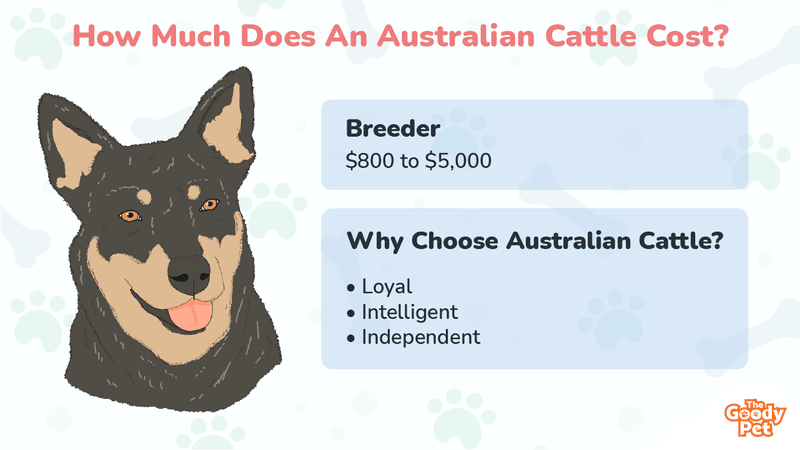Australian Cattle Dogs cost between $800 to $5,000. They are energetic and are not suited to live in the city or suburbs, with children or other pets. They are not very friendly to strangers either, which results in their lower demand and relatively cheaper price. They need a lot of food to keep up with their intense energy but don’t require much grooming since they will get dirty often. However, training is a must, so expect to pay around $300 per month for maintenance costs.
Are Australian Cattle Dogs Expensive?
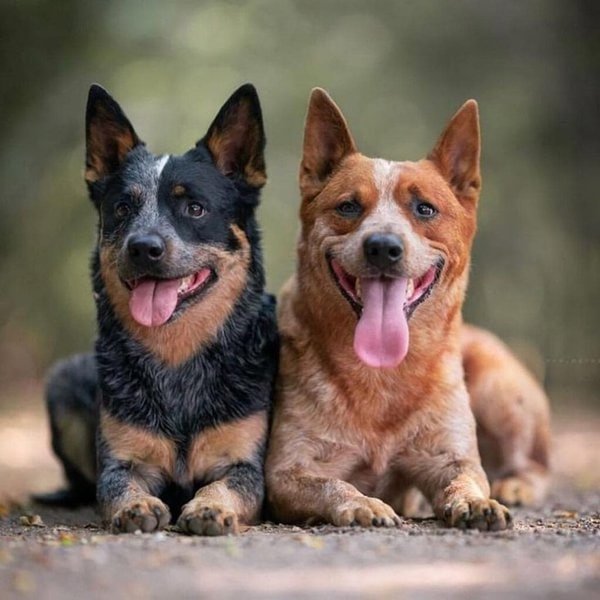
Australian Cattle Dogs go for $800 to $5,000 depending on where you buy yours from.
If you buy it from a breeder in a different country or a different state, you are more likely to get price tags on the higher end of the range. However, if you use online forums to buy from individuals as opposed to licensed breeders, you may end up paying less.
Whatever the case, they are still quite expensive and here are just some of the reasons why.
Lineage
Lineage probably plays the biggest role in determining the value of a dog and Australian Cattle dogs are no different. Those from champion bloodlines or lineages where common diseases have been bred out tend to be way more expensive than regular or even mixed breed options.
Great Companion Pet And Family Dog
Another reason you may have to pay so much is the fact that Australian Cattle Dogs are in fairly high demand when it comes to keeping as family pets or for first-time dog owners. This is largely due to their gentle nature and the fact that they tend to be a lot easier to manage than most other breeds with herding backgrounds despite having the same intelligence and discipline.
Training
Another factor that may determine how much you pay for your Australian Cattle Dog is whether or not they are trained. Trained puppies often cost more especially if you are getting more than just basic and obedience training. These puppies retail for upwards of $1,800 depending on the skill level.
How Long Does An Australian Cattle Dog Live?
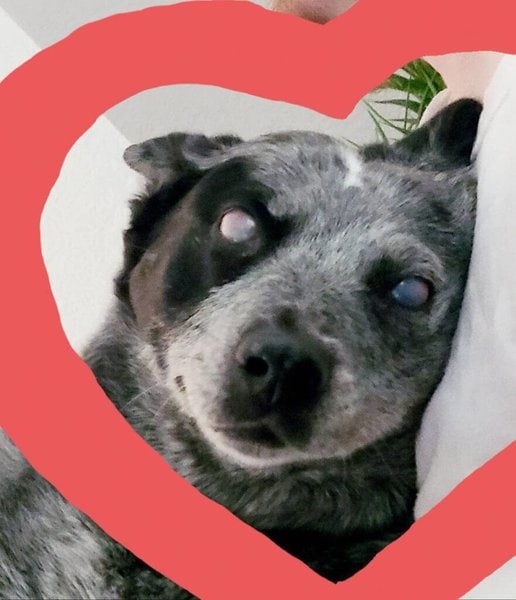
Australian Cattle Dogs are healthy dogs that have a long lifespan of 13 to 15 years.
These medium-sized Australian Cattle Dogs grow up to 30 to 50 pounds in weight and 17 to 20 inches in height. Due to intense selective breeding by most breeders, they tend to have very few health issues if any at all. Here are a few of those you may have to deal with and that contribute to sickness and death in the breed.
Progressive Retinal Atrophy
This condition results in progressive loss of sight in both eyes. Unfortunately, there is not much that can be done to reverse the process. However, there are some simple steps including dietary changes and supplementation that could slow down the progression.
Elbow Dysplasia
This is a condition where the socket in the elbow joint does not form properly resulting in an unstable joint. With time and frequent exercises, the dog may develop arthritis which just worsens their discomfort. The disease is mainly problematic because the Australian Cattle Dog is typically very active and outdoorsy and this condition limits their ability to enjoy their lives.
Congenital Deafness
This is associated with the Piebald gene that gives some of the dogs their hypopigmented coat markings. You may not actually notice that your dog is deaf when they are younger which is why regular vet visits for full reviews are important. That way, if the dog is deaf you can adapt their care and training to give them as normal of a life as you can.
How To Take Care Of Australian Cattle Dogs?
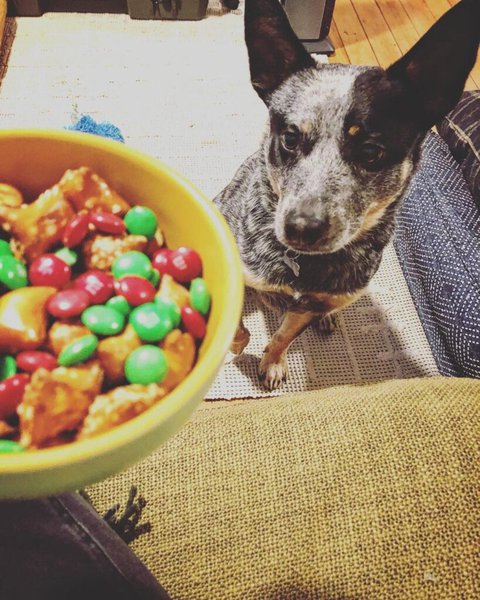
Taking care of an Australian Cattle Dog is about getting the dog to that perfect combination of health and happiness. Fortunately, this is quite easy to do with just a few steps. If you are a first time dog owner or a first time Australian Cattle Dog parent, here is all you need to know about taking care of the pooch.
Get The Diet Quality And Quantity Right
When it comes to feeding your Australian Cattle Dog, you need to ensure that you get both the quality and quantity right. The dog is generally very healthy and while genetics are the main reason for this, a healthy diet is crucial to maintaining the status quo.
The quantity also matters a lot as Australian Cattle Dogs are very energetic and thus need the calories to keep up with these needs.
Finding dog food straight off the shelf to meet all these needs is not always easy. However, you could try Pet Plate for a specially curated meal plan that takes your dog’s specific needs including their breed into consideration.
Include Multivitamin Supplements In Their Diet
Even with the highest quality foods, there are some micronutrients that you have to supplement in your pooch’s diet to ensure that they are getting a truly balanced diet. Supplements are often the only way to ensure this which is why they should be a big part of your care routine for your doggy.
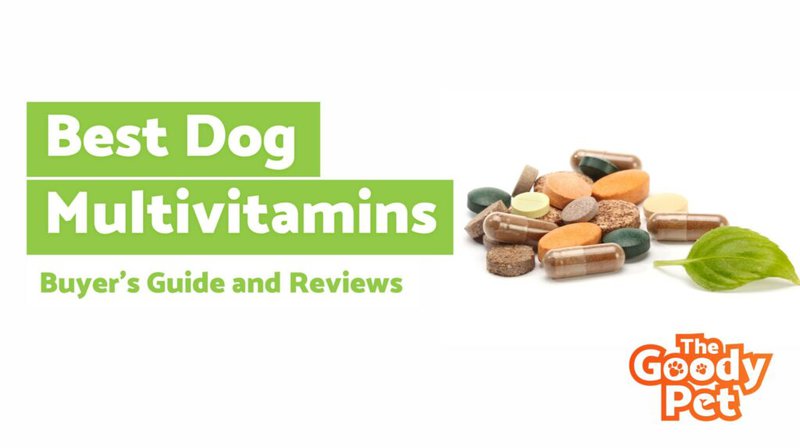
Get Them 1 To 2 Hours Of Exercise Every Day
If you live somewhere like in an apartment where the dog does not have a lot of free outdoor space to explore, it is your job to actually intentionally take them out every day for exercise.
These high energy Australian cattle dogs need about 1 to 2 hours a day of any physical activity, from swimming to running or even playing catch at the park. This helps keep them healthy while also engaging them mentally to avoid frustration and misbehaving including nibbling and biting out of boredom.
Are Australian Cattle Dogs Barkers? Temperament Of Australian Cattle Dogs
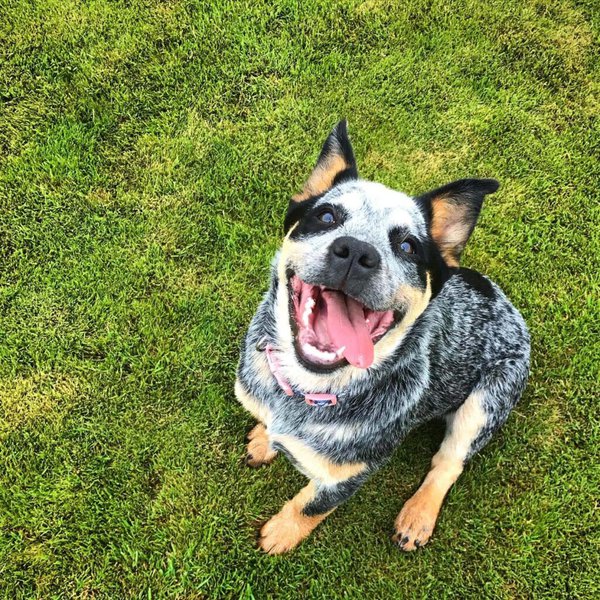
One of the best things about living with an Australian Cattle dog is how awesome their personalities are. These doggies will get along with pretty much anyone especially if they are socialized from an early age. Here are just a few of the key personality traits you have to look forward to owning one of these pooches.
Highly Energetic And Playful
Technically speaking, Australian Cattle Dogs are not aggressive even when they bark too much and they seem on attack mode. The high energy levels and extreme playfulness are what most people misconstrue as aggression.
Loyal
While Australian Cattle Dogs have a social side and will do well in large families, they tend to form the strongest bonds with maybe one or two individuals in the home. This makes them perfect one-person dogs that will be loyal almost to a fault to their solitary companion. They also definitely do not mind the undivided attention.
Independent
Australian Cattle Dogs are quite independent and can often be left alone for up to even 6 to 8 hours without causing too much of a fuss. They are also quite disciplined even with no one watching so you don’t have to worry about them wreaking havoc in your home when you’re not around.
These traits also make the Australian Cattle Dogs among the few breeds that you can trust to be unproblematic off-leash.
Dominant Personality
Australian Cattle Dogs are typically not dangerous towards humans. However, their dominant personalities often put them at odds with other dogs as well as with smaller pets like cats.
Intelligent
According to dog behaviorist Stanley Coren, Australian Cattle dogs are among the 10th most intelligent dog breeds. This makes them quite easy to train both in terms of basic obedience and complex skills.
Professional training will cost you about $100 per week which can be quite a lot over time. You could save money and have pretty similar results if you train your pooch yourself. In this case, tools like the Brain Training for Dogs program are invaluable offering you all the guidance you need to actually make the training work.
How Often Should You Bathe An Australian Cattle Dog? Grooming Tips For Australian Cattle Dogs
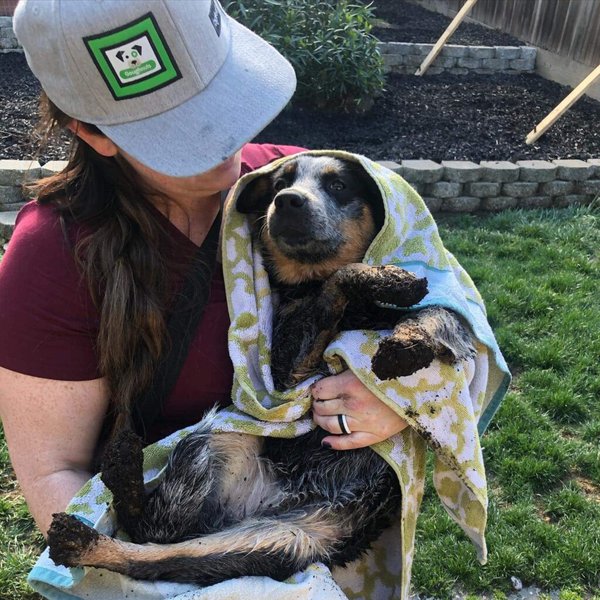
Australian Cattle Dogs have short, water-resistant and dirt-resistant coats. This trio of traits makes them very easy to maintain as far as grooming is concerned. Professional grooming will cost you $40 to $50 per session for grooming which translates to about $240 to $300 every year or more.
You could also do it yourself if you have the right tools, grooming products, and a schedule that works for you and your dog. Whether you choose to go professional or DIY, below are some of the most important grooming needs you need to get covered.
Brush The Coat 3 To 4 Times A Week
Australian Cattle Dogs shed minimally and therefore do not need too much brushing. In fact, you can get away with doing it once or twice a week. However, they shed heavily twice a year during fall and spring in which case you have to brush them 3 to 4 times a week.
Give The Pooch A Bath Once Every Month Or Two
Fortunately, Australian Cattle Dogs actually enjoy water which makes DIY baths a lot easier. Depending on how dirty your dog gets, you can wash them once every month or two. If they have skin issues whether from allergies or parasites, we recommend that you use grooming products with natural oils that help soothe and restore the skin.
Maintain Oral Hygiene
Australian Cattle Dog breath can be something out of a horror movie if not taken care of. Fortunately, all you need are good chew toys and dental dog water additives to take care of the plaque and bad breath respectively.
If you manage to train your dog to be comfortable with tooth brushing, you could also make this regular with a once a day schedule working just fine.
Related Questions
What Is The Difference Between A Blue Heeler And An Australian Cattle Dog? The Australian Cattle dog is actually the same breed as the Blue Heeler. In fact the Blue Heeler is nothing more than an Australian Cattle Dog with a blue coat. The other option in the same breed is the red heeler. They get the “heeler” part of the name from their habit of nibbling at the heels of their cattle charges as well as their human companions.
What Is The Bite Force Of A Australian Cattle Dog? The bite force of an Australian Cattle Dog is about 195 PSI. Technically speaking, this is not the highest of bite forces in the canine world. However, it is still quite a lot of force and could inflict a lot of damage especially to children and to small pets like cats and hamsters.
Can Cattle Dogs Hunt? Yes, Australian Cattle Dogs can actually be used for hunting in addition to their herding abilities. They are fast, focused, intelligent, and very loyal. They are also instinctively drawn to hunting, especially small prey. Their high intelligence levels also makes them easy to train for special hunting tasks like retrieval and tracking.

